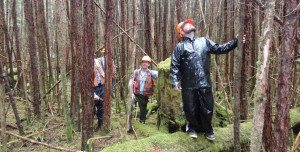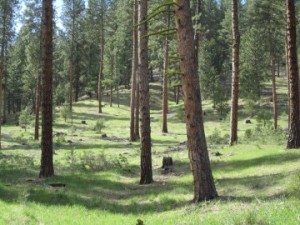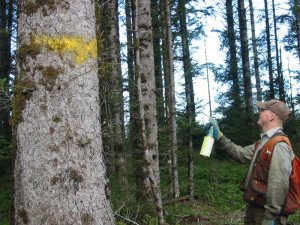
When preparing raw land for your log home building site, proper attention to the forested areas can maintain beautiful surroundings, foster wildlife and even provide some materials to incorporate into your home.
The first step to take with a wooded parcel is to have a professional forester assess your tree population. To maintain healthy and continuous growth, it’s important to identify trees that may have reached the end of their mature growth stage. Larger trees should be culled from the forest to encourage healthier undergrowth and allow young trees to develop into mature specimens as well. A forester can assess the mix of hard-and softwoods on the property, identify potential pests or diseases and educate you on the species that may provide value if harvested.
 Many forested states have foresters who work for the state or University Extensions and are available to walk the land and assess the trees and other features on your property. They may also be able to identify a local logger who can selectively harvest trees to create healthy long-term growth and mill some wild trees such as birch, cherry, oak or maple for use within your home.
Many forested states have foresters who work for the state or University Extensions and are available to walk the land and assess the trees and other features on your property. They may also be able to identify a local logger who can selectively harvest trees to create healthy long-term growth and mill some wild trees such as birch, cherry, oak or maple for use within your home.
Hiring a logger for selective harvesting
In Maine, loggers are available for site preparation and tree harvesting for homeowners. Some excavation companies may also have tree crews used to clear sites in advance of the excavators. One advantage of using a true woodsman logger is that you may be able to strike  a deal for payment using the harvested logs, especially if your parcel has commercially viable trees. A logger is also much more likely to have the skills to take trees out that improve the forest, as well as smaller, more nimble equipment to tease out specific trees from the forest. A good rule to keep in mind is the carpenter’s “measure twice, cut once.” Once trees are harvested, it will take many years to grow replacements.
a deal for payment using the harvested logs, especially if your parcel has commercially viable trees. A logger is also much more likely to have the skills to take trees out that improve the forest, as well as smaller, more nimble equipment to tease out specific trees from the forest. A good rule to keep in mind is the carpenter’s “measure twice, cut once.” Once trees are harvested, it will take many years to grow replacements.
Clearing the roadway
Having reviewed the likely location of your road in, clearing trees on that path is a little more straightforward than selective harvesting in other parts of the property. Your trees may be trimmed close to the ground, or cut 3-4 feet up to provide the excavator enough leverage to push over and remove the main root balls of trees. Taking as much of the tree below ground as above can minimize settling on the road bed as tree debris rots. Local practice depending on soil types will likely dictate whether stumps are pulled or left in place.
While reviewing the road site with the logger, it may make sense to identify tree species that have shallower root systems. Once these trees are exposed through cutting, they may be more vulnerable to blow down and could pose hazards for your roadway in bad weather. If your property was previously cut, there may also be a “tote” road created by the loggers to transport the trimmed logs out of the woods. These are generally easy grades and fairly direct routes, so if your property has a tote road, it may make sense to incorporate it into your own private roadway.
